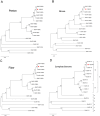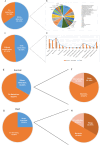Clinical features of HAdV-55 in children with respiratory tract infections: a retrospective case series and literature review
- PMID: 40247166
- PMCID: PMC12007208
- DOI: 10.1186/s12879-025-10890-x
Clinical features of HAdV-55 in children with respiratory tract infections: a retrospective case series and literature review
Erratum in
-
Correction: Clinical features of HAdV-55 in children with respiratory tract infections: a retrospective case series and literature review.BMC Infect Dis. 2025 May 6;25(1):664. doi: 10.1186/s12879-025-11060-9. BMC Infect Dis. 2025. PMID: 40329197 Free PMC article. No abstract available.
Abstract
Background: Human adenovirus type 55 (HAdV-55) can lead to acute respiratory diseases, significant morbidity, and mortality in children.
Methods: Hospitalized children diagnosed with HAdV-55 between September 2016 and March 2024 at the Children's Hospital of Chongqing Medical University were retrospectively analyzed. HAdV-55 was detected through polymerase chain reaction and sequencing. Clinical data were collected, including demographic characteristics, clinical manifestations, laboratory findings, imaging results, treatment history, and prognosis. A literature search was conducted using the PubMed database and China National Knowledge Infrastructure from their inception to June 2024. Search terms included "HAdV-55", "HAdV-11a", "adenovirus type 55" and their derivatives. Clinical features were evaluated in conjunction with literature on HAdV-55 infections in children.
Results: Five children with HAdV-55 infection were identified, including one mild, two severe, and two critical. The two critical patients exhibited progressive declines in total blood cell counts, hemoglobin levels and serum albumin levels within a short period. Adenoviral DNA was detected in pleural fluid or serum for them. They received mechanical ventilation, intravenous immunoglobulin, Methylprednisolone, blood transfusions, and antibiotics, while died for acute respiratory distress syndrome (ARDS). The remaining ones recovered and were discharged with good prognosis. A review of 56 cases, including those from this study, revealed that 61.9% (26/42) of infections were classified as severe or critical, with a mortality rate of 16.4% (9/55). Sequelae included bronchiolitis obliterans and bronchiectasis.
Conclusions: The genetic inheritance of HAdV-55 remained stable, with an upward trend of HAdV-55 severe infection among children from 2000 to 2019. Early clinical symptoms of HAdV-55 infection were overlapped with other respiratory viral infections. Rapid declines in blood cell counts, hemoglobin levels and serum albumin, along with dynamic monitoring of viral loads in sterile fluids, may serve as prognostic indicators.
Keywords: ARDS; Children; Clinical features; HAdV-55; Infection.
© 2025. The Author(s).
Conflict of interest statement
Declarations. Ethics approval and consent to participate: The study was approved by the Ethics committee of Children’s Hospital of Chongqing Medical University (reference number: 2024 Lunar Review (Research) No. (217)) and conducted in accordance with the Declaration of Helsinki. Written informed consent was obtained from the parents or legal guardians of all participants under 16 years of age. Consent for publication: Not applicable. Competing interests: The authors declare no competing interests.
Figures




References
-
- Lynch JP, Kajon AE, Adenovirus. Epidemiology, global spread of novel types, and approach to treatment. Semin Respir Crit Care Med. 2021;42(6):800–21. - PubMed
-
- HAdV Working Group. http://hadvwg.gmu.edu/. Accessed 10 Jan 2024.
Publication types
MeSH terms
Grants and funding
LinkOut - more resources
Full Text Sources

